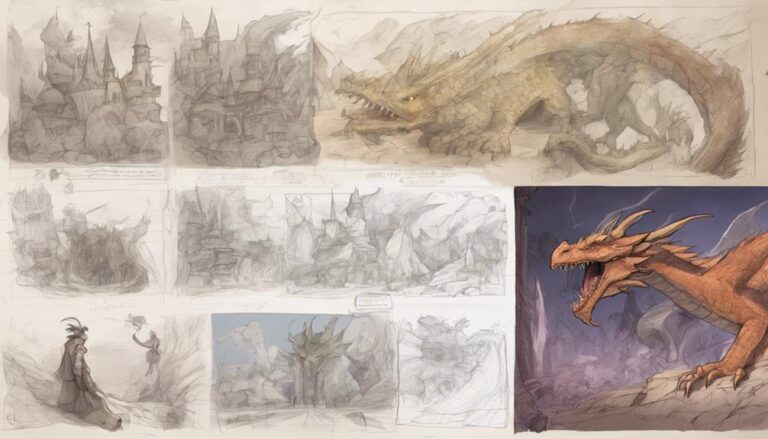3 Essential Tips for Online Traditional Animation Courses
When working through online traditional animation courses, you'll need a strategic combination of artistic skills, online learning habits, and professional presentation to excel in this field. First, focus on mastering traditional animation basics, such as the 12 principles of animation and drawing from life. Next, develop effective online learning strategies, including creating a dedicated learning space and sticking to a schedule. Finally, consider building a strong online portfolio that showcases your best work and presents it in a clear, visually appealing way. By implementing these essential tips, you'll set yourself up for success and pave the way to further discovery.
Key Takeaways
- Master the 12 basic principles of animation to build a solid foundation in traditional animation techniques.
- Create a dedicated learning space and establish a schedule to stay organized and focused in online courses.
- Develop strong drawing skills through exercises like gesture drawing, contour drawing, and drawing from life.
- Actively participate in virtual classroom discussions and activities to get feedback from instructors and peers.
- Build a professional online portfolio to showcase skills and versatility as a traditional animator.
Mastering Traditional Animation Basics
Mastering traditional animation basics is a crucial step in becoming a skilled animator.
You'll need to develop a solid foundation in the fundamentals of animation. This involves understanding the 12 basic principles of animation, including squash and stretch, anticipation, staging, and timing.
To apply these principles effectively, you'll need to practice drawing exercises that help you develop your skills in drawing and motion.
Focus on exercises that improve your drawing skills, such as gesture drawing, contour drawing, and drawing from life.
You should also practice drawing exercises that help you understand motion and timing, such as drawing a bouncing ball or a walking character.
As you progress, you'll need to apply the animation fundamentals to more complex exercises, such as animating a character's emotions or actions.
Consistently practicing drawing exercises will help you develop your skills in traditional animation.
By mastering the basics, you'll be able to create more believable and engaging animations.
Remember to be patient and persistent in your practice, as mastering traditional animation basics takes time and effort.
Effective Online Learning Strategies
Now that you have a solid foundation in traditional animation basics, it's time to focus on how to effectively learn and apply these skills in an online environment.
Effective online learning strategies are crucial to staying on track, meeting deadlines, and achieving your goals.
- Create a dedicated learning space that's quiet, comfortable, and free from distractions.
- Develop a schedule and stick to it, setting aside dedicated time for watching lectures, practicing skills, and participating in virtual classroom discussions.
- Use time management tools, such as calendars and to-do lists, to stay organized and on track.
- Actively participate in virtual classroom discussions and activities, asking questions and seeking feedback from instructors and peers.
- Take breaks and practice self-care to avoid burnout and maintain productivity.
Building a Portfolio Online
As you progress in your online traditional animation course, a strong portfolio becomes essential for showcasing your skills to potential employers and demonstrating your growth as an artist.
Having a solid portfolio can help you stand out in a competitive industry and make a lasting impression on potential clients.
To create a strong portfolio, you should curate a selection of your best work that showcases your skills and versatility as an animator.
Organize your portfolio into clear sections or categories, and use relevant keywords to help potential employers quickly find the work they're interested in.
Building a portfolio online also requires a strong digital presence and a clear online branding strategy.
This means creating a professional website or profile on platforms like Behance, DeviantArt, or LinkedIn.
When building your online portfolio, consider the user experience: make it easy to navigate, and ensure that your work is presented in a clear and visually appealing way.
Frequently Asked Questions
Can I Learn Traditional Animation Without Drawing Skills?
You can still learn traditional animation even without drawing skills, as you'll develop them through practice and mastering art fundamentals; some people with learning disabilities even discover hidden talents through animation's unique, expressive medium.
How Long Are Typical Online Traditional Animation Courses?
When searching for online courses, you'll find that typical course durations vary greatly, but most range from 3-12 months. You'll appreciate flexible scheduling, as it allows you to learn at your own pace, fitting it into your busy life.
Are Online Courses as Effective as In-Person Training?
You might wonder if online courses can match in-person training. Fortunately, virtual classrooms and online mentorship have bridged the gap, offering personalized guidance and real-time feedback, making online learning just as effective.
What Software Is Required for Traditional Animation Courses?
You'll need software like Adobe Animate or Toon Boom Harmony for traditional animation courses. Your software preferences may vary, but typical animation tools include drawing tablets, digital painting programs, and specialized plugins for smooth workflow.
Can I Get a Job With an Online Animation Certificate?
You can get hired with an online animation certificate, as it's often about industry recognition and your skill level. Focus on building a strong portfolio, and you'll increase your chances of landing a job in the field.
Conclusion
You've now laid the groundwork for success in online traditional animation courses. By focusing on mastering the basics, employing effective online learning strategies, and showcasing your work in a strong portfolio, you'll be well-equipped to achieve your goals. As you progress, stay committed to continuous learning and practice. Regularly assess your progress, and don't hesitate to seek feedback from instructors and peers to refine your skills and stay on track.







